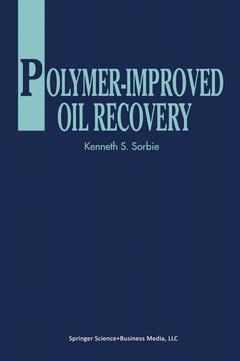Description
Polymer-Improved Oil Recovery, 1991
Author: Sorbie K.S.
Language: English
Subject for Polymer-Improved Oil Recovery:
Keywords
carbon; chemistry; classification; combustion; development; efficiency; fluid mechanics; gas; polymer; research; reservoir; economic geology
Approximative price 316.49 €
In Print (Delivery period: 15 days).
Add to cart
Publication date: 04-2014
359 p. · 15.2x22.9 cm · Paperback
359 p. · 15.2x22.9 cm · Paperback
Description
/li>Comment
/li>
The importance of oil in the world economy cannot be overstated, and methods for recovering oil will be the subject of much scientific and engineering research for many years to come. Even after the application of primary depletion and secondary recovery processes (usually waterflooding), much oil usually remains in a reservoir, and indeed in some heterogeneous reservoir systems as much as 70% of the original oil may remain. Thus, there is an enormous incentive for the development of improved or enhanced methods of oil recovery, aimed at recovering some portion of this remainil)g oil. The techniques used range from 'improved' secondary flooding methods (including polymer and certain gas injection processes) through to 'enhanced' or 'tertiary' methods such as chemical (surfactant, caustic, foam), gas miscible (carbon dioxide, gas reinjection) and thermal (steam soak and drive, in-situ combustion). The distinction between the classification ofthe methods usually refers to the target oil that the process seeks to recover. That is, in 'improved' recovery we are usually aiming to increase the oil sweep efficiency, whereas in 'tertiary' recovery we aim to mobilise and recover residual or capillary trapped oil. There are a few books and collections of articles which give general overviews of improved and enhanced oil recovery methods. However, for each recovery method, there is such a wide range of interconnected issues concerning the chemistry, physics and fluid mechanics of flow in porous media, that rarely are these adequately reviewed.
..recommended for polymer libraries as this is the most significant book covering the technology of polymers in enhanced oil recovery - Air Products and Chemicals, ..can serve both as a superb reference for experts and as a good starting point for those just entering the area - R S Seright, New Mexico Petroleum Recovery Research Center, This book successfully fills a gap in the published literature that has been sadly lacking to date...I believe the book to be an extremely valuable addition to the IOR subject area, ideal for researchers engaged in potential field assessments. - Scientific Drilling, The author has avoided extensive mathematical derivations and has made careful reference to laboratory observations on cores and polymer solutions. Throughout, the text gives evidence of great care of his part to make the subject assimiable to as wide a readership as possible....Overall, I can recommend this book, particularly to those directly involved with reservoir modelling. It contains much that is better collected and presented there than in other texts or papers. - Transport of Porous Media
© 2024 LAVOISIER S.A.S.



